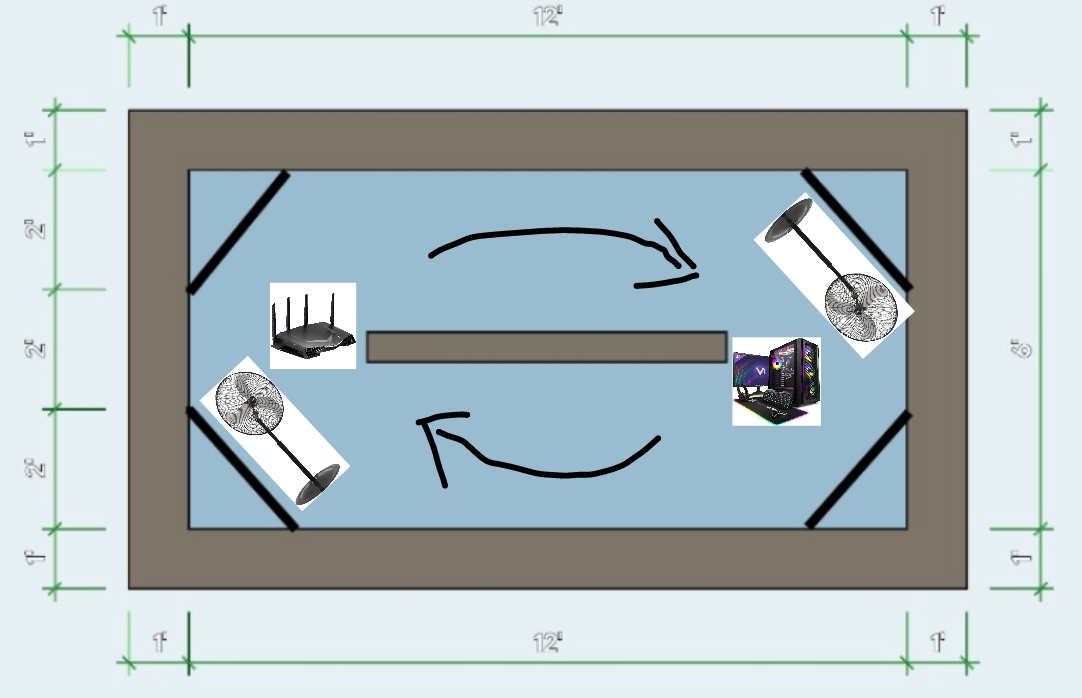Yes, but the tailwind becomes a headwind on the way back to the router so you won’t see any actual speed changes. Putting a fan on both ends will cancel each other out too.
You need to change all the gaseous air out for either liquid or a solid as waves propagate faster through them. You should start with filling your house with liquid oxygen as a nice half step so you still have something to breathe easily, as solids are a bit more tricky.
No, the fan will blow the packets all over the place, which is fine for UDP, but any TCP/IP connection will suffer. Place the fan in front of the router so that the blades will catch any dropped packets and throw them back into the datastream.
uh, hi. If you place the blades in front of the router, it will start chopping the packets before they even reach. You need to use an bladeless fan
Everyone know that.
yes.
It’s not 1 way traffic. Signals go both ways. To increase your wifi speeds, have 1 fan blow from your router to your device and 1 fan from your device blow towards your router. Signals go faster in warm air so make sure to pump up the thermostat. It also goes faster with less CO2 in the air so make sure to open all windows (unless you own a Mac). Lower moisture in the air also improves speeds, so crank your AC on max. Also placing both your router and device in rice helps.
device in rice
Say that in any linux forum :)
If you can create a vacuum with said fan, it can be faster.
The Wifi isn’t waves made of air, the wifi is waves of the electromagnetic spectrum, similar to visible light, and they travel faster than you can perceive.
So no.
But you can do something similar with a microwave oven. It’s just that any signal making it through the radiation of the oven would be disfigured and useless.
I mean, that was my first thought… but would there be a measurable difference?
I mean lets be clear, with a fan you’re adding like 8 mph to something going 299,792,458 meters per second. You won’t notice anything.
But like, vacuum vs glass vs glass moving half the speed of light, could be an interesting what if. Relativity is always where my mind glosses over in physics.
Unless the air particles make real contact with the photons then you’re not adding anything to anything, and the ones that do will be deflected.
Imagine a rock in space coming close to hitting a planet, or even entering a solar system at all. Similar scale.
Sort of a serious answer because I’m bored: You’re thinking of speeding up the air when what you should be thinking about is speeding up the waves. But then your waves are reaching you plenty fast already with latency being in the single digit ms range. Not much of a point in trying to accelerate that, really. You won’t notice anyway.
If you feel like your internet connection via Wi-Fi is slow then the bottleneck is probably not with the Wi-Fi part of your network but the Internet Access Point behind it. Or even further down the line.
Now this is based on the assumption that you are in a fairly typical network environment, i.e. using semi-current hardware with moderate, if any, electromagnetic interference in the area. If you’re living right next to a high voltage transformer station and using a router from 2008 then, yes, you’re going to have Wi-Fi performance issues.
But in most cases, people complaining about “slow Wi-Fi” are actually suffering from Internet connectivity issues.
Think of it this way: If you enjoy your McDonald’s from the local franchise but you can only get 100 burgers per hour from them (of course you need MOAR!) then upgrading your 320hp Camaro to a 400hp Mustang is not going to enable you to pick up appreciably more burgers from the drive through in the same amount of time.
Not entirely true.
In an apartment in the middle of a city, noisy neighbours can be a problem.In those cases, it’s best to jump to 5 GHz, and leave the 2.4 band alone.
Except if you have an ECOVACS cleaning robot which refuses to work with modern 5GHz networks. I actually had to install a Wi-Fi bridge to get around that limitation; thankfully, I still had one lying around. Helped me get a better signal for my phone in the bathroom as well.
But thank you for adding this information. Congestion due to interference from other networks (I guess that’s what you meant) can definitely be a factor as well. I guess that’s the problem with the notion of “normal” that I employed rather carelessly.
Sidenote: the fact that your Wi-Fi still works in those conditions at all instead of shutting down goes back to pioneering research done by actress-cum-scientist Hedy Lamarr during WW2. Amazing woman.
which refuses to work with modern 5GHz networks.
Companies that make IoT devices do this so they can save a bit of money. It lets them use lower end, cheaper wifi chips (or left over older-generation chips that they can buy at a discount). I’m not really a hardware person but apparently 2.4Ghz wifi radios are a lot simpler than 5Ghz ones. Apparently they’re also $2-$3 cheaper which adds up when you’re producing a lot of units.
Also, the 5Ghz band differs per country. For example, some channels are authorized in the USA but not in Europe. Some companies stick to 2.4Ghz to avoid having to make anything region-specific.
There are plenty of things in a normal home that can cause serious signal attenuation (just installed new energy efficient windows? whoops! those IR blocking coatings severely attenuate microwave signals too). Poor AP placement is a very common cause of “slow wifi” and has nothing to do with your internet uplink.
Again, you point out why “normal” is an iffy notion to begin with. Thank you for elaborating instead of just downvoting. 🙂
Failing to fully utilize the existing antenna diversity options on modern routers/APs might be another common cause that comes to mind.
Remember: These people vote.
Reminder: most voters are the people.
Yes, but then it’s slower for your computer to talk back to your Wi-Fi, so it ends up cancelling out
Push-Pull Config

We can streamline this by making the room into 2 small tunnels from the router to the PC. This way there will be less obstacles in the room. But we need to add leafblowers on each side with a boost button.
What if we make the tubes really really small and wrap them in many protective layers to prevent other wind sources from messing with the signal.
At that point why even bother with the air at all, we could just send electrical signals. Or even light.
you could also hook into the router and wireless card of the computer to make each of them turn on the corresponding leaf blower whenever they’re sending something. of course you’d probably have to implement some kind of queuing system so only one blower is active at a time, but it will all be worth it for the speed gains
Interestingly, this could be true and you could never find out experimentally iirc.
I watched a veritasium video about the 1 way speed of light vs 2 way that talked about it.
I watched the same video!
I was right about to disagree and type “wait this only applies to light” but then I remembered: radio is light.
Crazy to think about that!
It is nuts. It goes to show how far science goes proving things through deductions rather than direct observation. So much science is done that way.
I think that there would be some infinite energy glitches if it was actually true that light was faster 1 direction than another, so I think the assumption is a good one. But still fun facts
LOL! Yes, one has to consider this. ZOMG your’s is the best comment!
Le reddit moment tips cap to you sir
This.
Yes but you have to put a slit in front of it so the wifi waves turn into wifi particles.
yes but pages will render kinda wavy i use a box fan myself for maximum speed
So if I put a fan behind a source of light, shouldn’t that make the particles faster?
Yeah but it’s gonna scramble your signal, then send it spinning outwards.
Not inherently stupid question; they just don’t know that radio waves don’t travel through air but through space.
What is space exactly?
they just don’t know that radio waves don’t travel through air but through space
does this mean radio waves can go to mars? if so, why don’t we ride them to mars?
You’d need a very small saddle.
It’s not much of a stupid question even given that - for a refractive medium, speed of light can change with its movement. Though for air it’ll be extremely hard to directly notice; it has n≈1.0003 so speed of light in air is already 0.9997c, and increasing it to, say, 0.9998c would require moving the air at 0.166c.
Stupid laws of nature, making everything cool super hard and expensive!
But air is empty space?! /s
Yeah, but it evens out since now your messages going back to the router have to swim upstream.
Could this be remedied by sending packets on a second antenna, with a fan blowing in the opposite direction?
Only if the two air streams don’t intersect, otherwise you’ll create a dead zone. Modern signal jammers are actually highly sophisticated fans.
You must never cross the streams









